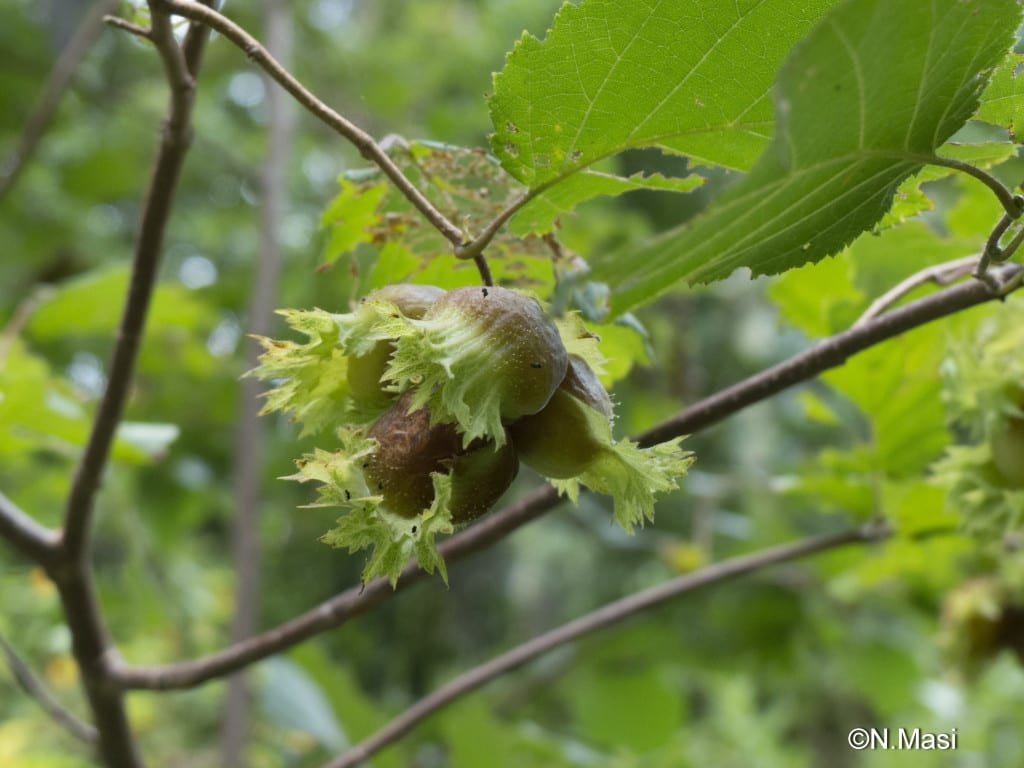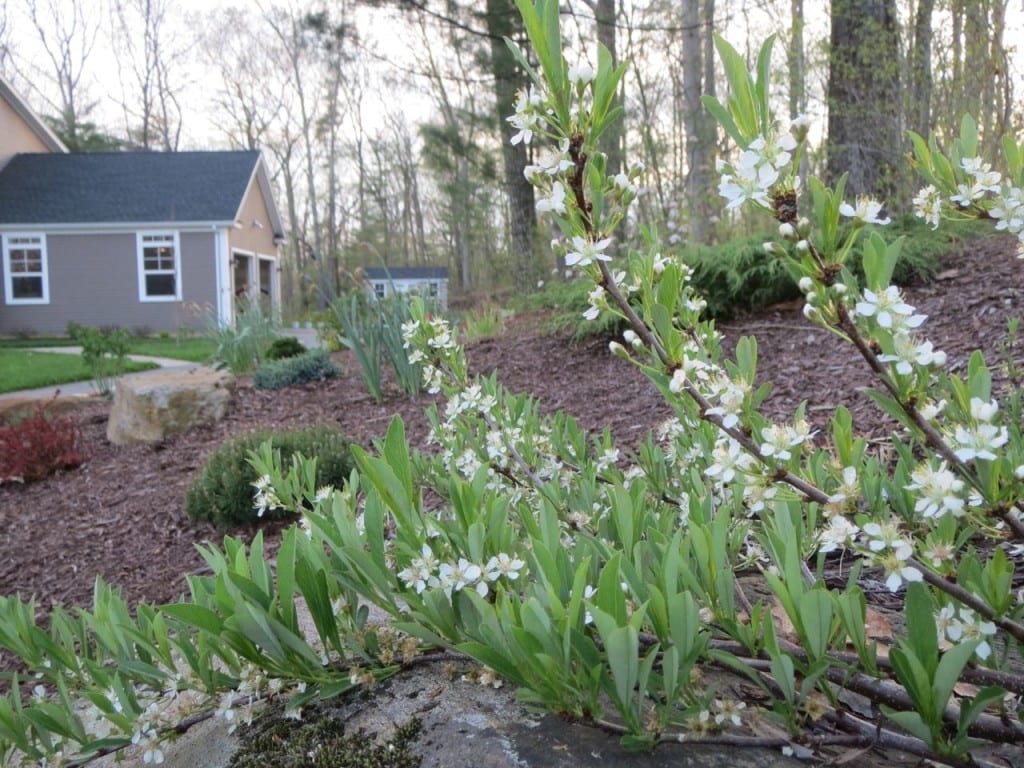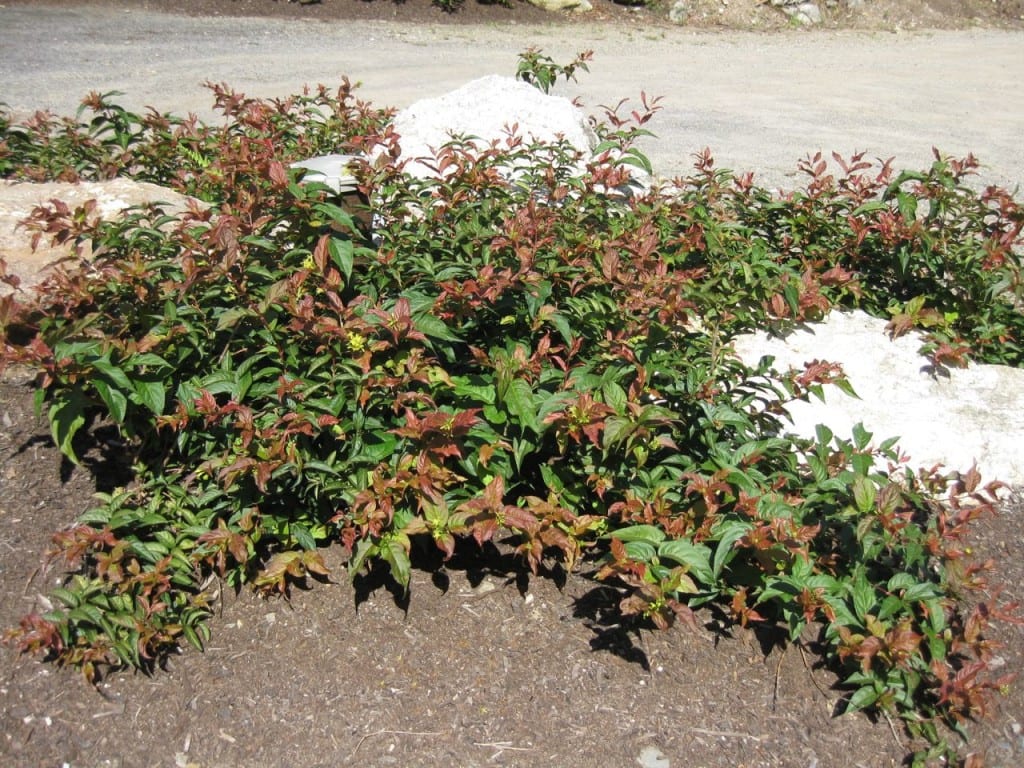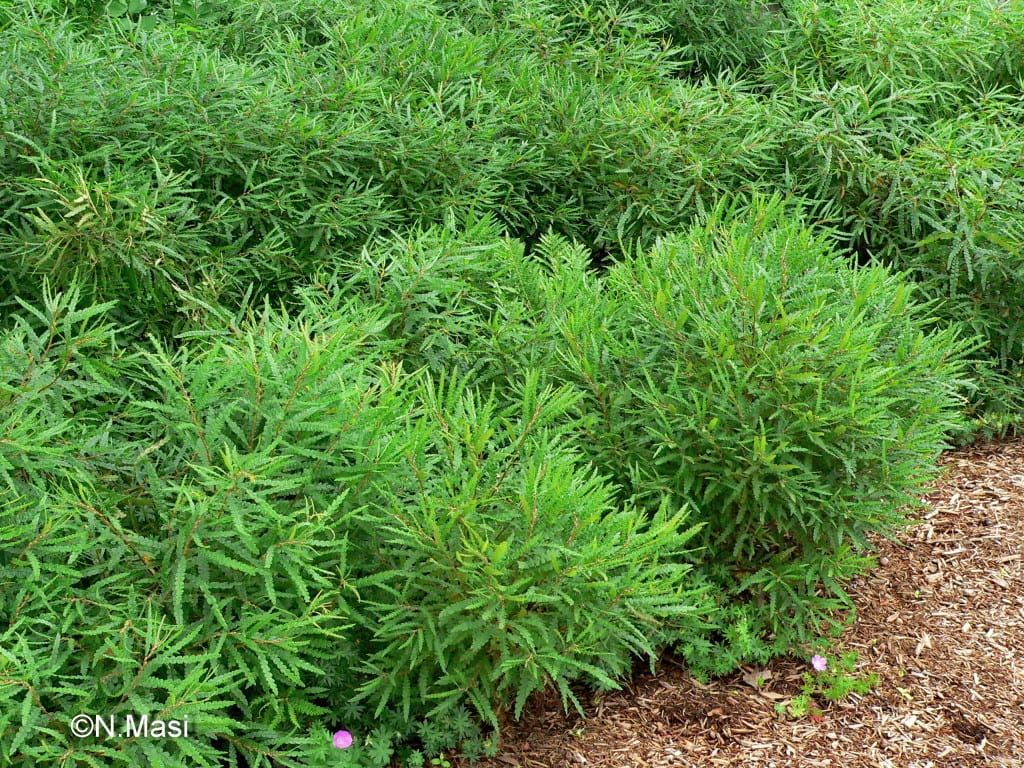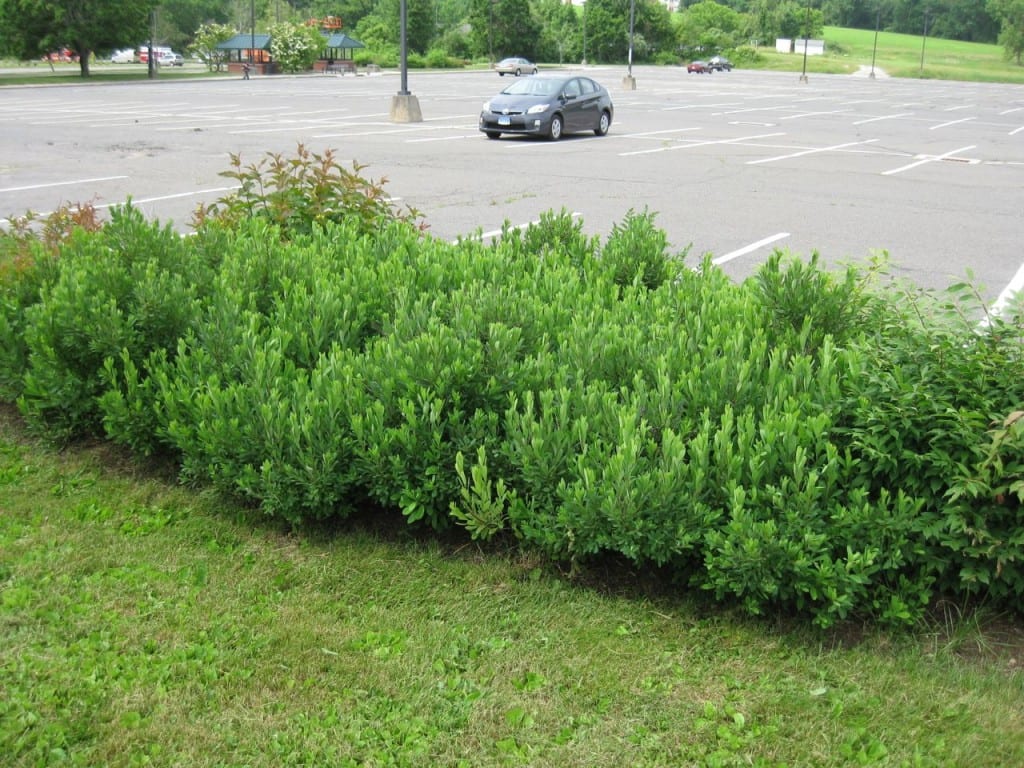This article previously appeared in the Connecticut Botanical Society Newsletter
by Dr. Jessica Lubell
The sustainable landscape featuring native plants is a rapidly expanding trend in horticulture. Native plants enhance the local ecology by providing habitat for wildlife and support for pollinators. A number of important ornamentals have been identified as invasive and will no longer be available due to plant bans, both voluntary and involuntary. Native species are by definition not invasive and offer a sustainable alternative.
One of the components of my research and extension program at the University of Connecticut has been the evaluation of native shrubs for landscape suitability. When established in landscape sites similar to their natural habitat, native shrubs require little maintenance and are well adapted to local soils and climates. However, if native shrubs are going to be successful as replacements for invasive species, it is critical that they be well adapted to landscape use. The majority of landscape situations involve relatively harsh conditions, which might include reflected light, high temperatures, inadequate water supply, infertile soil, road salt and pedestrian pressure.
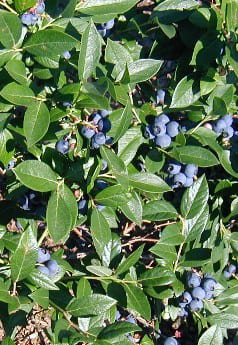
Planted as a substitute for invasive winged euonymous, highbush blueberry often performs poorly or dies.
Some native shrubs, such as winterberry holly (Ilex verticillata), arrowwood viburnum (Viburnum dentatum) and creeping juniper (Juniperus horizontalis), are already widely used for landscaping and have proven themselves to be adapted to typical landscape situations. The green industry would benefit from a broadened palette of versatile and adaptable native plants to meet the growing desire to utilize natives in landscaping. One of the issues associated with native plants has been their blind recommendation without knowing their landscape adaptability and the false notion that all native plants are well suited for landscape purposes. For example, highbush blueberry (Vaccinium corymbosum) is commonly recommended as a substitute for invasive winged euonymus (Euonymus alatus) because both have vibrant red fall foliage. However, blueberry is not well adapted to the locations where winged euonymus is used, and it performs poorly or dies. Failed attempts at using native plants result in future reluctance of homeowners, landscapers and growers to embrace native species as viable alternatives to invasive species.
Testing Adaptability
The adaptability of native shrubs has received only limited research attention, and we don’t really know how suitable they might be for challenging landscape sites. To test the adaptability of native shrubs, I have planted over a dozen native species in the ultimate challenging-landscape site – a commuter parking lot on the University of Connecticut campus in Storrs, CT. The test species were identified as potential candidates for use as invasive plant alternatives based on the diversity of their natural habitats. Each of the chosen species provides ornamental interest, but none have been used extensively for landscaping, because their landscape adaptability was unknown. Invasive Japanese barberry (Berberis thunbergii) and winged euonymus (Euonymous alatus) were also planted as controls to understand how the natives perform compared to these tough, old landscaping standbys.
In order to generate sound data, significant replication was built into the native shrub evaluation to be sure that what I observed was not anomalous. At the UConn parking lot site, a minimum of 25 plants of each species were installed in a replicated experimental layout. Plants were mulched with four inches of softwood bark and hand weeded as necessary. Plants were irrigated three times weekly for the first four weeks after planting, and twice weekly for the next six weeks. In spring one year after planting, shrubs were fertilized with a balanced granular synthetic fertilizer at a rate of 2 lbs. of nitrogen per 1000 sq. ft. Plants were evaluated for aesthetic quality, deer resistance, and growth rate.
Eight native species had excellent performance, equivalent to the invasive control plants, Japanese barberry and winged euonymus. Several other test species showed significant promise and with further research may prove to be suitable landscape plants. Some species warranting further evaluation include Cornus racemosa (gray dogwood), Cornus rugosa (round leaf dogwood), Lindera benzoin (northern spicebush), Sambucus canadensis (elderberry), and Spiraea tomentosa (steeplebush). One plant that performed quite poorly in the parking lots was Vaccinium corymbosum (highbush blueberry).
Let’s take a look at what each of the best performing eight native shrubs has to offer our landscapes.
American filbert (Corylus americana)
These plants have a pleasant form, interesting textured leaves, edible fruits with unique involucres and respectable fall color. In the full-sun parking lot site, plants produced a dense, uniform rounded habit, which is contrary to the sparse open plants seen in the wild where plants are growing in moderate to dense shade. After three growing seasons in the parking lot, the plants were 36 inches tall and 38 inches wide. American filbert experienced moderate deer browsing during the first two establishment years in the parking lot. Plant them in groups to create a naturalistic landscape or along the edge of woods to integrate the cultivated yard with the natural surroundings. American filbert can also function well in foundation plantings.
Buttonbush (Cephalanthus occidentalis)
Buttonbush is an upright, spreading, medium to large flowering shrub. Better specimens sport glossy dark green foliage and numerous golf-ball-sized flowers that often age to reddish pink fruits. It was surprising how well buttonbush adapted to the dry, well-drained parking lot soil conditions, considering this plant occupies wet habitats in the wild, such as swamps and bogs and the edges of lakes and rivers. In three years, plants reached 64 inches tall and 62 inches wide. Plants exhibited slight to moderate damage from deer browsing. Use buttonbush for naturalizing, in the shrub border, or for screening. Just be sure to provide adequate space, so that plants can develop to their maximum potential.
Creeping sand cherry (Prunus pumila var. depressa)
Creeping sand cherry maintains a low profile (less than 1 ft.) and is considered a groundcover. Plants produce copious amounts of five-petaled white flowers in early spring (April to May) as the foliage emerges. Leaves initially have an orange tint and mature to lime green with silver undersides and turn orange red in fall. Plants produce small black fruits, typical of other wild cherry species. Creeping sand cherry is widely adaptable to full sun sites and will tolerate dry conditions. In the parking lots, plants had moderate damage from deer browsing, but regrew quickly. Use them at the front edge of shrub borders or foundation plantings for a gradual transition to taller specimens. Plant in rock gardens or above retaining walls, allowing their branches to flow over these garden elements. Creeping sand cherry is useful for sunny slopes and stabilizing banks. It has similar habit and performance to Rhus aromatica ‘Gro-low’ and gives us an additional choice of native groundcover.
Northern bush honeysuckle (Diervilla lonicera)
Plants in the parking lot produced dense mounds, 48 inches tall and 59 inches wide, with coppery red new foliage color, which slowly faded to green. Small tubular yellow flowers in bunches at the tips of shoots appear in June. At the start of the flowering period, plants produced a heavy bloom and flowered more or less continuously throughout the season into late September. Plants experienced moderate deer-browse damage during the first two establishment years in the parking lot. Use northern bush honeysuckle in mass plantings or in repetition in the landscape. It can also work well as a facer plant to hide the bases of leggy plants. Northern bush honeysuckle spreads slowly by rhizomes and should be used in sites where plants can be allowed to spread and cascade, such as on a gravelly bank or above a rock wall.
Sweet fern (Comptonia peregrina)
Sweet fern is desirable for its dark green fern-like foliage and the sweet fragrance it produces, most noticeably on warm sunny days. Plants in the parking lot performed exceedingly well, producing dense, uniform mounds up to 42 inches tall and 60 inches wide. Plants never exhibited damage from deer and appear to be deer-resistant. Sweet fern should be massed or repeated in the landscape. It can be used in foundation plantings or as low hedge along a walkway in full sun to light shade. It can also be used to stabilize a gravelly bank by a driveway or road due to its rhizomatous nature, ability to fix nitrogen, and salt tolerance. Sweetfern has a reputation for being a short-lived plant, however our parking lot plants are still looking lush and healthy with no signs of decline going into their sixth growing season.
Sweet gale (Myrica gale)
This shrub has an interesting candelabra-like, multi-stemmed suckering habit that uniformly fills an area. Plants in the parking lot reached 36 inches tall and 55 inches wide. The frosty lime green foliage is scented, especially when bruised, and the aroma was noticeable in the parking lot on warm days. Sweet gale will tolerate light shade and infertile soils, the latter due to its nitrogen-fixing ability. Use it in groups, mass plantings or as a low informal hedge. Sweet gale is a good foundation plant due to its compact size and ability to tolerate reflected light. Site plants near a window to enjoy the aromatic foliage indoors. Sweet gale is deer-resistant.
Sweetbells (Eubotrys racemosa)
Sweetbells performed exceedingly well in the challenging parking-lot conditions and was deer-resistant. This plant’s habit resembles highbush blueberry, but sweetbells is smaller in stature, reaching 3 to 6 ft. at maturity. Foliage is glossy and emerges with a reddish cast before turning dark green in summer and then a spectacular scarlet red in fall. The small, white, urn-shaped flowers resemble those of highbush blueberry or drooping leucothoe. They give off a light fragrance you can detect when close to a sweetbells plant. Sweetbells is a plant to consider as a replacement for invasive burning bush because of its excellent red fall color. Use as a foundation plant, screen, or in mass plantings.
Virginia rose (Rosa virginiana)
Virginia rose is a low-growing (2 to 4 ft. tall) deciduous shrub with upright shoots and a dense, rounded habit. Glossy dark green summer leaves turn orange-red in the fall. The fragrant, five-petaled, pink flowers are two to three inches in diameter. Maximum flowering occurs in early summer, and then plants will bloom sporadically into late summer. Numerous, large, red-orange hips are produced, making for a showy fall display. Virginia rose grows best in sites with full sun exposure. It may be used in masses or in the shrub, or mixed perennial, border. Plants may be pruned to shape and trained into a low, informal hedge. Due to its colonizing habit, Virginia rose may be used to stabilize sunny slopes. It can also be used at the edge of water or near low-lying, seasonally damp areas. Plants in the parking lots experienced repeated light deer browse, but were able to break new buds and retain dense habit and healthy appearance.
Addressing Availability
Currently, buttonbush, sweetfern and northern bush honeysuckle are available in the nursery trade. Sweet gale, creeping sand cherry, Virginia rose and American filbert are somewhat available, and sweetbells is not available. Native plant availability (or lack there of) is often cited as an impediment to broader use of natives in landscaping. This begs the question, what can be done to ease the availability issue? The answer starts with an understanding of what nurseries do in order to bring plants to market.
Availability starts with demand, which is generated through public awareness and education about what native species are good plants to use in the landscape. Next, consumers need to demand these plants from growers. Once growers receive the message, they need to figure out how to produce the plants. The time required to produce plants in response to demand is considerable, and consumers need to understand that there is going to be a lag period in availability for new natives.
Here is the typical way nurseries grow plants. Production starts with cutting propagation, followed by growth in containers using a bark-peat-sand growing medium and controlled-release fertilizer. Containers are lined out in nursery growing blocks where they are irrigated, pruned, spaced, overwintered, transplanted, and re-spaced over a period of three to five years, before delivery to market.
To produce attractive, uniform crops in only three to five years requires a lot of water and high fertility. Plants that will not tolerate these growing conditions present a greater challenge for producers. When new plants do not grow well using established production methods, growers have to make adjustments to accommodate the new crop. This might include altering the growing media composition, fertility level, rate of irrigation, or timing of transplanting to larger containers of salable size. The longer the time it takes to adapt a new crop to container production, the longer the lag time to market.
Growers often prefer to propagate plants from cuttings instead of seed, because cuttings produce uniform crops and the majority of consumers want uniform plants that will perform identically in the landscape. Furthermore, cultivars, which outsell un-improved stock, require clonal propagation by cuttings. For a plant to be profitable in large-scale commercial production, it must propagate from cuttings at a success rate greater than 70%.
Several of the lesser-known native shrubs I have discussed here, like creeping sand cherry, sweet gale, sweetbells and Virginia rose, should easily integrate into existing production protocols. A plant like American filbert may present some production challenges and, therefore, will be in more limited supply and have a higher price early on.
A broader palette of high quality native plants is on the way. Consumers will just have to be a little patient and let the system ramp up. It’s not going to happen overnight, but it will happen.
About the Author
Dr. Jessica Lubell is an Associate Professor of Horticulture at the University of Connecticut. She has 15 years of experience working with the green industry. She has worked closely with growers to expand production of new native shrubs. Dr. Lubell is the 2015 recipient of the New England Nursery Association Young Nursery Professional Award. You can follow her research and outreach work on Facebook at Native Plant Gal.
Each author appearing herein retains original copyright. Right to reproduce or disseminate all material herein, including to Columbia University Library’s CAUSEWAY Project, is otherwise reserved by ELA. Please contact ELA for permission to reprint.
Mention of products is not intended to constitute endorsement. Opinions expressed in this newsletter do not necessarily represent those of ELA’s directors, staff, or members.

